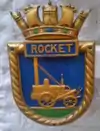HMS Rocket (H92)
HMS Rocket was an R-class destroyer of the Royal Navy that saw service during Second World War. Built by Scotts Shipbuilding and Engineering Company in Greenock, Scotland, she was launched in October 1942 and commissioned in August 1943.
 HMS Rocket circa. 1945 | |
| History | |
|---|---|
| Name: | HMS Rocket |
| Ordered: | May 1940 |
| Builder: | Scotts Shipbuilding and Engineering Company, Greenock |
| Laid down: | 14 March 1941 |
| Launched: | 28 October 1942 |
| Commissioned: | 4 August 1943 |
| Reclassified: | Type 15 frigate from 1951 |
| Identification: | pennant number H92/F191 |
| Motto: | 'Upward and Onward' |
| Fate: | Sold for scrapping in 1967 |
| Badge: |
 |
| General characteristics As R-class destroyer | |
| Class and type: | R-class destroyer |
| Displacement: |
|
| Length: | 358.25 ft (109.19 m) o/a |
| Beam: | 35.75 ft (10.90 m) |
| Draught: | 9.5 ft (2.9 m) |
| Propulsion: | 2 x Admiralty 3-drum water-tube boilers, Parsons geared steam turbines, 40,000 shp (30,000 kW) on 2 shafts |
| Speed: | 36 kn (67 km/h) |
| Range: | 4,675 nmi (8,658 km) at 20 knots (37 km/h) |
| Complement: | 176 |
| Sensors and processing systems: |
|
| Armament: |
|
| General characteristics As Type 15 frigate | |
| Displacement: |
|
| Length: | 358 ft (109 m) o/a |
| Beam: | 37.75 ft (11.51 m) |
| Draught: | 14.5 ft (4.4 m) |
| Propulsion: |
|
| Speed: | 31 kn (57 km/h) (full load) |
| Range: | 4,675 nmi (8,658 km) at 20 knots (37 km/h) |
| Complement: | 174 |
| Sensors and processing systems: | |
| Armament: |
|
Service
Second World War
During the Battle of Sept-Îles, Rocket encountered German torpedo boats in the English Channel in October 1943, an action in which the cruiser Charybdis and destroyer Limbourne were lost. The latter was sunk by Rocket after she became disabled, to avoid her falling into enemy hands. On 29 November 1943 HMS Rocket and HMS Tumult, sank U-86 east of the Azores, in position 40°52'N, 18°54'W, by depth charges.[2] Arriving in the Indian Ocean in January 1944, Rocket participated in the shelling of Sabang (25 July 1944) and of the Andaman Islands (February and March 1945).
Post-War
_underway.jpg.webp)
In 1946 Rocket was at Chatham and between 1946 and 1948 she was used as an air target ship at Rosyth. In 1949 she was placed into reserve at Portsmouth. Between July 1949 and 1951 she was converted at Devonport Dockyard into a Type 15 fast anti-submarine frigate, with the new pennant number F193.
On 18 May 1951 she was re-commissioned for the 3rd Training Squadron, based in Derry.[3] In 1953 she took part in the Fleet Review to celebrate the Coronation of Queen Elizabeth II.[4] In 1954 she returned to reserve at Rosyth, before being re-commissioned the following year. In November 1956 she returned to reserve at Chatham, then transferred to the reserve at Portsmouth the following year. On 28 October 1960 she was re-commissioned at Portsmouth and sailed to the Far East to join the 6th Frigate Squadron.
Decommissioning and disposal
Rocket returned to Portsmouth on 11 May 1962 and de-commissioned. She was finally scrapped at Dalmuir in March 1967.
References
- Raven, Alan; Roberts, John (1978). War Built Destroyers O to Z Classes. London: Bivouac Books. p. 47.
- "Allied Warships HMS Rocket (H92)". uboat.net.
- Critchley, Mike, "British Warships Since 1945: Part 3: Destroyers", Maritime Books: Liskeard, UK, 1982. ISBN 0-9506323-9-2, page 54
- Souvenir Programme, Coronation Review of the Fleet, Spithead, 15th June 1953, HMSO, Gale and Polden
Publications
- Colledge, J. J.; Warlow, Ben (2006) [1969]. Ships of the Royal Navy: The Complete Record of all Fighting Ships of the Royal Navy (Rev. ed.). London: Chatham Publishing. ISBN 978-1-86176-281-8.
- English, John (2001). Obdurate to Daring: British Fleet Destroyers 1941–45. Windsor, UK: World Ship Society. ISBN 978-0-9560769-0-8.
- Friedman, Norman (2006). British Destroyers & Frigates: The Second World War and After. Annapolis, Maryland: Naval Institute Press. ISBN 1-86176-137-6.
- Lenton, H. T. (1998). British & Empire Warships of the Second World War. Annapolis, Maryland: Naval Institute Press. ISBN 1-55750-048-7.
- Marriott, Leo, Royal Navy Destroyers Since 1945. Ian Allan, 1989. ISBN 0-7110-1817-0
- Raven, Alan & Roberts, John (1978). War Built Destroyers O to Z Classes. London: Bivouac Books. ISBN 0-85680-010-4.
- Rohwer, Jürgen (2005). Chronology of the War at Sea 1939–1945: The Naval History of World War Two (Third Revised ed.). Annapolis, Maryland: Naval Institute Press. ISBN 1-59114-119-2.
- Whitley, M. J. (1988). Destroyers of World War 2. Annapolis, Maryland: Naval Institute Press. ISBN 0-87021-326-1.